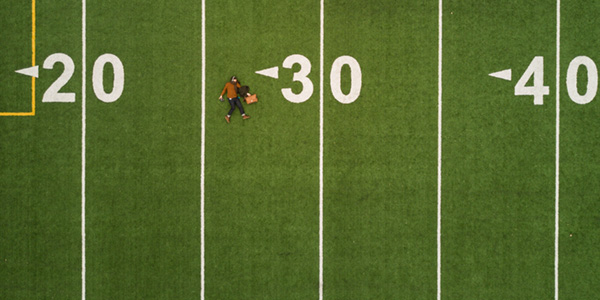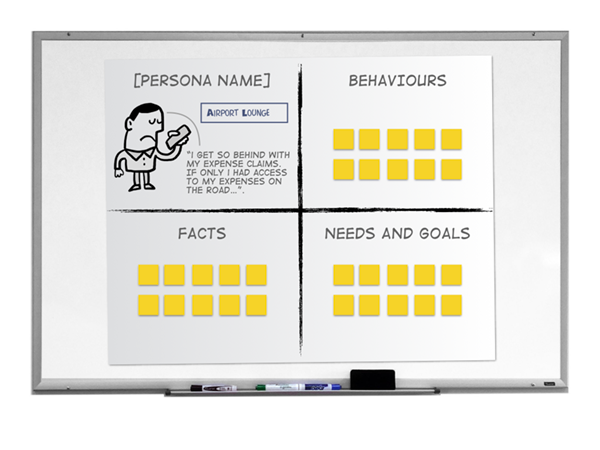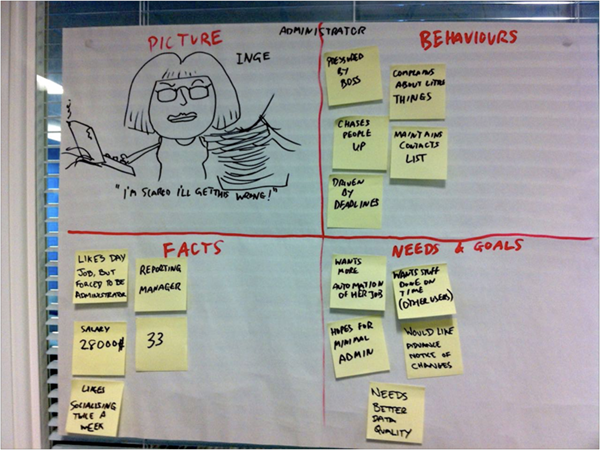|
View this email in your browser Workshop 5: Create an assumption persona
In the previous workshop, you identified one or more groups of users that you can learn a lot from and who are relatively easy to get to. In this workshop, you are going to create an assumption persona for one of those groups. The assumption persona you will create in this workshop will be based on guesses, hunches and preconceptions. None of the conclusions you draw may actually be correct. (That's the bad news). The good news is that you will use the assumption persona as the springboard for research and find out which bits are right and which bits are wrong. Prepare a few sheets of flip chart paper, some Sharpies and a pack of sticky notes. Call a design meeting and get your team to attend. Begin by coming to a shared understanding of the work you have done up to this point. Review the business goals, the user experience vision, the research questions from the desk research you carried out, and the user groups you identified. Ensure you have identified the main groups of user that you can learn a lot from and that are relatively easy to get to. Then choose a group to be the focus of your initial research study. The next step is to create an assumption persona — the team's best guess about the details of this user — on a sheet of flip chart paper. If your team is small (2-3 people) you'll work on this together. If you have a large design team, split the team into groups of 2-3 people. Each team will create their own version of the assumption persona and you'll compare designs afterwards and create a consolidated version. If you can’t decide on just one user group in the top right quadrant, create additional personas as needed. Arrange the flip chart paper in landscape format and split it into four quadrants. Label the quadrants like this:
Label the top left quadrant with a name for this user type. Draw a sketch showing this user type in a context having some thought that's relevant to your product. In my example, I've drawn a picture of an business user of expenses software. The picture isn’t very realistic, but it doesn’t matter: your goal here is to show the person in a context. In my drawing, you can make out that the persona is a bit miserable, that he's using a mobile phone and that he's in an airport lounge. The quotation provides some insight into the persona's motivations around the use of the product. Label the bottom left quadrant 'Facts'. Using sticky notes, list the facts you know to be true about this user type (such as gender, age, occupation, job title, the town they live in, their educational attainment level, their employment status, their family size, their first language, their marital status, their nationality, their parenthood status, their socioeconomic status). Which facts you decide to put down depend on your persona, on the product and on the persona's context. Put one fact per sticky note and aim for about 10 sticky notes in total. Label the top right quadrant, 'Behaviours'. Ask yourself: what does this user type want to do with the product? What "job" are people using the product for? What does your persona need from your product to get the right outcome? What do they currently do that's related to usage of the product? For example, if you're thinking of designing a new kind of wearable fitness device, then typical behaviours might be, "Sets fitness goals", "Cycles 3-5 times per week", "Attends Zumba classes". Note how each of these behaviours begins with a verb: that's important because behaviours are verbs, not nouns. If you find yourself writing nouns (like "built-in heart rate monitor", "waterproof" and "GPS") then you're thinking in terms of the implementation of your product. Don't do that yet. Put one behaviour per sticky note, and aim to identify at least 5 different behaviours. Label the bottom right quadrant, 'Needs and goals'. Ask yourself: how do users want to feel when using the product? Ultimately, what do users want to achieve with the product? What is this user type’s deep drives and motivations? Avoid platitudes like, "Be happy" or "Be more confident" as everyone wants this. Instead ask: What does your persona need that's related to the use of your product and that will make them feel happy and more confident? What benefits will your persona get from using the product? Again, for our fitness app, this might be: "Have more energy to play with kids", "Improve posture" and "Get sick less frequently". Put one need/goal per sticky note. Here's an example of what one team I worked with created. True, it's not pretty. But unlike those beautiful persona templates that you've seen in the past, at least this one acknowledges that it's a work in progress.
If you worked in teams for this activity and created more than one persona, ask each team to now present their persona and form a consolidated persona. The final step is to look at your persona and identify the riskiest assumptions. Here are some good questions to ask:
Choose up to 5 assumptions. Highlight them on your persona template. Keep them safe. These assumptions will be the focus of your field visit in an upcoming workshop. Further training in user experienceIf you want to dive deeper, then try my video course on Udemy. Here's the link: User Experience: The Ultimate Guide to Usability and UX. I can also train your team in user experience. Here's more information about that: In-house user experience training. Next week, we'll move on to Workshop 6, where you will create a recruitment screener to ensure you involve the right participants in your research. Until then, best of luck with your user research efforts. David Travis What's this all about? Did someone forward this link to you? Would you like to see the other user experience workshops? Find out more. |


